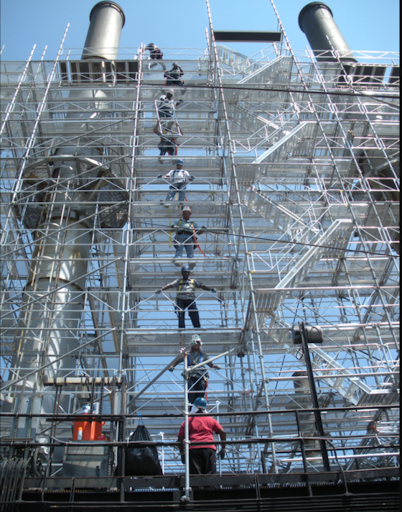Temporary Roof Scaffolding to Ensure Safe Working Conditions During Projects
Temporary Roof Scaffolding to Ensure Safe Working Conditions During Projects
Blog Article
Exploring the Numerous Sorts Of Scaffolding Used in Construction Projects
The construction sector relies greatly on various kinds of scaffolding to satisfy details job requirements, each offering unique advantages and applications. Standard frame scaffolding gives a durable structure for general jobs, while put on hold scaffolding is vital for job on high-rise frameworks.

Standard Structure Scaffolding
Traditional frame scaffolding is one of the most commonly used techniques in the building and construction market due to its toughness and versatility. This system contains vertical and horizontal structures that are assembled to create a secure system for materials and workers. The main parts consist of upright messages, horizontal journals, and angled braces, which together provide a solid framework that can sustain considerable loads.
Among the crucial advantages of typical framework scaffolding is its adaptability to numerous construction tasks, ranging from household structures to large business structures. The modular style enables simple setting up and disassembly, making it efficient for both long-lasting and temporary projects. Furthermore, the system can be tailored in height and width, suiting different building designs and website problems.
Security is extremely important in scaffolding applications, and conventional structure systems are equipped with guardrails and toe boards to stop drops and make sure worker defense. Normal examinations and adherence to safety policies are important in keeping the honesty of the scaffold (Scaffolding). In general, standard structure scaffolding continues to be a fundamental option in the building market, supplying a trusted platform for labor and enhancing overall project effectiveness

Suspended Scaffolding
Suspended scaffolding provides an unique solution for building and construction jobs that require accessibility to elevated surfaces, especially in circumstances where traditional structure scaffolding may be impractical. This sort of scaffolding is usually suspended from the roof covering or upper degrees of a structure, utilizing a system of systems, wheels, and ropes to create a functioning area that can be changed to various heights.
Among the primary benefits of put on hold scaffolding is its versatility. It can be conveniently repositioned or reduced to fit modifications in construction needs, making it excellent for tasks such as window setup, frontage work, and maintenance on skyscrapers. Additionally, the marginal impact of put on hold scaffolding allows for far better use ground area in city atmospheres, where area is usually limited.
Safety is a vital factor to consider in the usage of suspended scaffolding. In general, suspended scaffolding offers a efficient and reliable option for accessing hard-to-reach locations in different building situations, boosting both performance and safety and security on site.
System Scaffolding
System scaffolding, frequently considered a modern-day service in the scaffolding industry, contains pre-engineered parts that can be promptly constructed and adjusted for different building projects. Scaffolding. This kind of scaffolding is defined by its modular design, which allows for convenience and performance on task sites, accommodating architectural demands and different elevations
Normally made from high-strength steel or aluminum, system scaffolding offers boosted toughness and stability. The components consist of vertical blog posts, horizontal journals, and angled braces, which adjoin securely, ensuring a durable framework. The layout commonly incorporates standard fittings, streamlining assembly and disassembly procedures, thus reducing labor time and expenses.

Rolling Scaffolding
Moving scaffolding is a functional choice to traditional fixed scaffolding, developed for movement and simplicity of use on construction sites. This kind of scaffolding is composed of a system sustained by frameworks with wheels, allowing workers to conveniently transfer it as required. The movement feature considerably enhances performance, as it decreases downtime connected with disassembling and constructing check it out dealt with scaffolding.
Normally built from lightweight products such as aluminum or steel, rolling scaffolding offers a tough yet portable solution for tasks needing constant repositioning - Scaffolding. It is specifically beneficial in jobs such as painting, drywall installment, and electrical job, where accessibility to various elevations and locations is essential
Safety is paramount in rolling scaffolding layout, with features such as securing wheels to avoid unintended activity when being used, and guardrails to secure workers from drops. In addition, numerous versions are adjustable in height, suiting numerous job demands.
Cantilever Scaffolding

The layout of cantilever scaffolding commonly entails utilizing brackets or arms secured to a structure or framework, allowing the platform to expand exterior securely. Safety is critical; thus, these scaffolds have to be crafted to endure various loads and ecological conditions. Normal assessment and maintenance are important to ensure architectural stability and worker safety and security.
Cantilever scaffolding is favored for its adaptability and effective use area, making it a prominent choice in city atmospheres where room restrictions prevail. Furthermore, it facilitates less complicated access to high altitudes, eventually adding to the overall performance of building projects. As with all scaffolding types, correct training and adherence to security criteria are crucial for employees utilizing cantilever scaffolding.
Final Thought
Conventional framework scaffolding gives security, while put on hold scaffolding supplies flexibility for raised jobs. System scaffolding promotes fast setting up, and rolling scaffolding boosts flexibility for differing job atmospheres.
Conventional framework scaffolding offers a durable foundation for general tasks, while put on hold scaffolding is essential scaffolding accessories for job on skyscraper frameworks.Rolling scaffolding is a versatile alternative to traditional set scaffolding, created for wheelchair and simplicity of use on building sites. As with all scaffolding kinds, correct training and adherence to security requirements are crucial for workers making use of cantilever scaffolding.
Typical framework scaffolding offers security, while put on hold scaffolding provides versatility for raised tasks. System scaffolding helps with fast setting up, and rolling scaffolding enhances flexibility for differing work settings.
Report this page